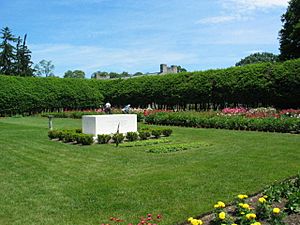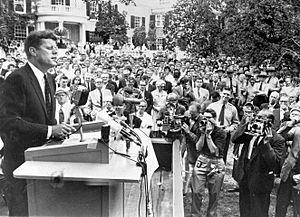Home of Franklin D. Roosevelt National Historic Site facts for kids
|
Home of Franklin D. Roosevelt
National Historic Site |
|

Springwood Estate at Franklin D. Roosevelt National Historic Site.
|
|
| Location | Hyde Park, NY |
|---|---|
| Nearest city | Poughkeepsie |
| Area | 800 acres (3.24 km²) |
| Built | 1800–1845 |
| Architectural style | Federal, Italianate |
| Visitation | 108,611 (2005) |
| Website | Home of Franklin D. Roosevelt National Historic Site |
| NRHP reference No. | 66000056 |
Quick facts for kids Significant dates |
|
| Added to NRHP | October 15, 1966 |
| Designated NHS | January 15, 1944 |
The Home of Franklin D. Roosevelt National Historic Site protects the Springwood estate in Hyde Park, New York. This special place was the birthplace, lifelong home, and burial site of Franklin D. Roosevelt. He was the 32nd President of the United States. This National Historic Site was created in 1945. It helps us remember an important part of American history.
History of the Roosevelt Home


How Did Springwood Begin?
In 1697, the English King gave a huge piece of land, about 220 square miles (570 km²), to nine businessmen from New York City. This land stretched from the Hudson River to the border of Connecticut. To make sure everyone could reach the river, the land along the shore was split into nine "Water Lots." Springwood is located on one of these lots. It was given to William Creed, one of the nine partners.
The first house on the Springwood estate was likely a large farmhouse. It was built around 1800 in the Federal style. In 1845, a New York City merchant named Josiah Wheeler bought the estate. He updated the house, giving it a popular Italianate style. This included a three-story tower and long porches. After his changes, the house had 15 rooms.
The Roosevelt Family Buys Springwood
In 1866, James Roosevelt, Sr., Franklin D. Roosevelt's father, bought the estate. It was about one square mile (2.5 square kilometers) at that time. He paid US$40,000, which was a lot of money back then. James loved horses, so the property's stable and horse track were very important to him.
James made many improvements to the house and land until he died in 1900. He made the servants' area bigger and added a large carriage house.
Franklin D. Roosevelt's Early Life at Springwood
Franklin was born in 1882 in a bedroom in the house's tower. This room was the main bedroom at the time. His childhood bedroom was also nearby on the same floor. In 1905, after marrying Eleanor Roosevelt, the young couple moved in with his mother. Springwood remained central to Roosevelt's life, no matter what he was doing.
How Was the House Enlarged?
In 1915, Franklin D. Roosevelt and his mother, Sara Roosevelt, decided to make the house much bigger. They wanted more space for their growing family. They also needed a grander place to host important political guests. Roosevelt had many ideas for the new design. His mother, Sara, paid for the work, so she also had to consider the cost.
They hired the firm Hoppin & Koen to design the changes. The house more than doubled in size. Two large stone wings, a tower, and a third story were added. The outside of the house was changed from wood to stucco. The porch was replaced with a stone terrace and a small entrance with columns. These changes made the house look like a mansion in the Colonial Revival Style.
Inside, the house kept much of its old layout. But it was redesigned to hold Roosevelt's many collections. He collected books, paintings, stamps, and coins. The remodeling was finished in 1916. Roosevelt also planted many trees around the estate. Between 1911 and his death in 1945, over 400,000 trees were planted. Parts of the estate became an experimental forest.
Springwood as the "Summer White House"
During his time as president, from 1933 to 1945, Franklin visited Springwood almost 200 times. He even built a smaller home called Top Cottage nearby. The main estate became his "Summer White House." Here, he hosted political friends and important people from other countries.
In June 1939, King George VI and Queen Elizabeth The Queen Mother from Britain visited Springwood. This was the first time a British monarch had visited the United States. Other important guests included British Prime Minister Winston Churchill. European royalty like Queen Wilhelmina of the Netherlands also visited.
Roosevelt also used the estate as a quiet place before three of his four presidential elections. When he won, he would go out onto the front terrace to give his victory speech.
Roosevelt's last visit to Springwood was in March 1945, shortly before he passed away. He wished to be buried in the Rose Garden near the sundial. He was buried there on April 15, 1945. His wife, Eleanor, was buried next to him after her death in 1962. Their famous dogs, Fala (a Scottish Terrier) and Chief (a German Shepherd), are also buried there.
Giving Springwood to the American People
In 1943, two years before he died, Roosevelt gave the estate to the American people. His family could still use the property during their lifetimes. On November 21, 1945, after his family gave up their rights, the estate was given to the U.S. Department of the Interior.
Since then, the National Park Service has managed Springwood as a National Historic Site. It is open to the public. In 2005, the site covered over a square mile and welcomed 108,611 visitors.
Exploring the Rooms of Springwood
The Entrance Hall: A Glimpse into Roosevelt's Interests
The walls of the entrance hall are covered with paintings from Roosevelt's collection. You can see many naval paintings and historical cartoons. There are also bird specimens from his childhood collection. A sculpture of him at age 29 is on display. In a corner, you'll find a special manually operated elevator. The disabled president used it to move between floors.
The Living Room and Library: A Collector's Dream
This room was where Roosevelt worked on his many collections. He had a personal library of about 14,000 books. He also collected over 2,000 naval paintings and prints. His other collections included:
- Over 300 bird specimens
- Over 200 ship models
- 1.2 million stamps
- Thousands of coins, banknotes, and campaign buttons
The Music Room: A Place for Guests
The music room is also called the "Dresden Room" because of some porcelain from Dresden, Germany. This formal room has many Chinese porcelain and lacquerware pieces. Roosevelt's mother's family bought these when they lived in China. This room and the dining room next to it were used for formal gatherings. A collection of signed photos of famous guests is kept on the piano.
Bedrooms of Eleanor and Franklin Roosevelt
When the house was made bigger in 1915, a set of rooms was created for Eleanor and Franklin Roosevelt. These rooms included a sitting room and two dressing rooms. In 1921, Roosevelt became very ill and could not move easily. One dressing room was then changed into a separate bedroom for Eleanor. The sitting room became a bedroom for his mother, Sara.
The "Snuggery": Sara Roosevelt's Special Space
This room was used by Roosevelt's mother, Sara, to start her day and manage the household. It was created in 1915 when the old South Parlor was divided. Even though the room became smaller, most of the old furniture was kept. This gives the Snuggery a cozy, full appearance.
Images for kids











